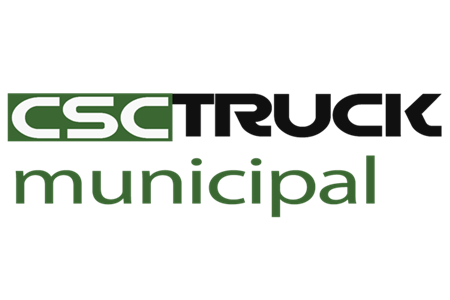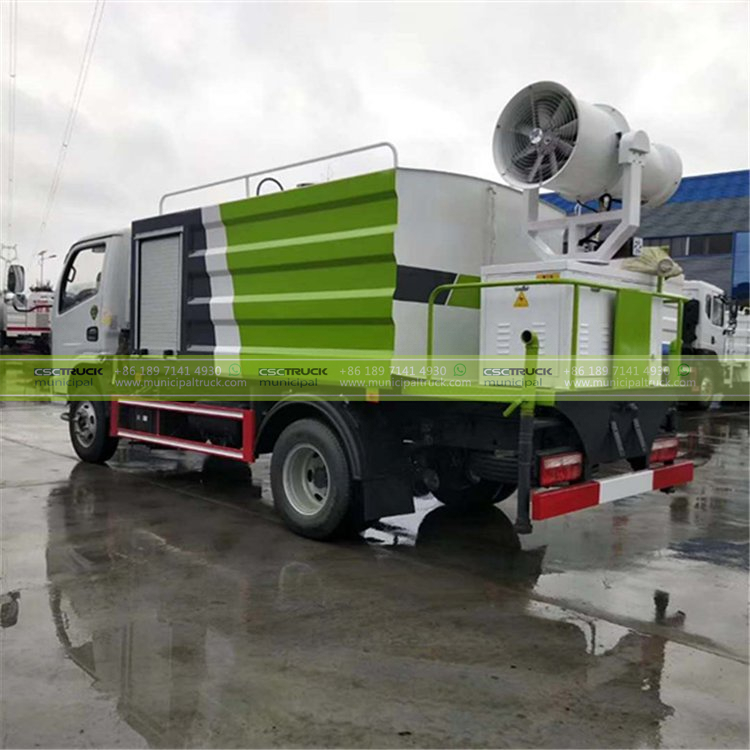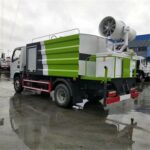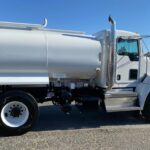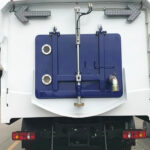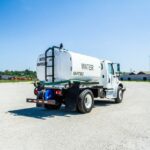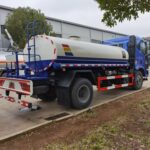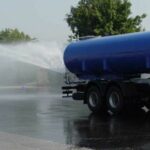In the demanding, inherently dusty environments of surface mining, quarrying, and large-scale earthmoving operations, controlling airborne particulate matter—particularly the insidious threat of respirable crystalline silica (RCS) and other hazardous dusts—transcends mere regulatory compliance to become a fundamental imperative for safeguarding worker health, ensuring operational continuity, minimizing environmental impact, and maintaining positive community relations. Traditional dust suppression methods, often reliant on coarse water sprays or chemical additives applied haphazardly, frequently prove inadequate against the complex aerodynamic behavior of fine dust particles generated by drilling, blasting, crushing, loading, hauling, and vehicular movement on unpaved haul roads; it is within this challenging context that the specialized engineering of modern water mist sprayer trucks emerges as a scientifically validated, highly effective, and increasingly indispensable solution for comprehensive dust exposure control across expansive and dynamic worksites.
The Invisible Hazard: Understanding Mine Dust Exposure Risks
Airborne dust in mining operations is not a monolithic entity but a complex mixture of particles varying drastically in size, composition, and associated health risks, with the fraction small enough to be inhaled deep into the alveolar regions of the lungs—known as respirable dust—posing the most significant long-term danger. Key hazards include:
- Silicosis and Progressive Lung Disease: Prolonged inhalation of respirable crystalline silica (RCS), a common component of rock and ore dust, triggers irreversible scarring and stiffening of lung tissue, progressively diminishing lung function, increasing susceptibility to infections like tuberculosis, and carrying a significantly elevated risk of developing lung cancer; this debilitating and often fatal disease remains a persistent occupational health scourge despite being entirely preventable.
- Coal Workers’ Pneumoconiosis (CWP): In coal mining, inhalation of coal dust leads to CWP, or “black lung,” characterized by inflammation, fibrosis, and the formation of nodules within the lungs, severely impairing respiratory capacity and quality of life.
- Exacerbation of Respiratory Conditions: Even non-specific dusts can aggravate pre-existing conditions like asthma, chronic bronchitis, and emphysema, leading to increased absenteeism, reduced productivity, and higher healthcare costs for the workforce.
- Operational and Environmental Impacts: Beyond health, uncontrolled dust compromises visibility, increasing accident risks, accelerates wear on machinery components (especially engines and hydraulics), contaminates local ecosystems through deposition, generates community complaints leading to potential permitting delays or restrictions, and directly violates increasingly stringent occupational exposure limits (OELs) enforced by agencies like MSHA (Mine Safety and Health Administration) and OSHA (Occupational Safety and Health Administration) globally.
The Science of Suppression: Why Fine Water Mist Outperforms Coarse Sprays
Conventional high-volume, low-pressure water sprays, while better than no suppression, suffer from fundamental physical limitations in capturing the most dangerous respirable dust particles, primarily due to the significant size disparity between large water droplets (often 500-2000 microns) and fine dust particles (typically below 10 microns, with RCS frequently below 5 microns). Water mist technology leverages precise engineering to overcome this mismatch:
- Optimal Droplet-Particle Interaction: By generating a dense cloud of extremely fine water droplets, typically in the 10-100 micron range through specialized high-pressure pump systems (operating at 70-200+ bar / 1000-3000+ psi) and engineered nozzles, mist sprayers dramatically increase the probability of collision between droplets and dust particles. The mechanisms of inertial impaction, interception, and Brownian diffusion become significantly more effective at this scale.
- Enhanced Surface Coverage and Residence Time: The low settling velocity of fine mist allows it to remain airborne longer, creating a persistent “curtain” or “blanket” effect that interacts with dust over a wider area and extended duration compared to rapidly falling coarse sprays, providing superior coverage over complex terrain and within dust plumes.
- Minimal Water Usage, Maximum Effectiveness: By focusing on droplet size rather than sheer volume, mist systems achieve superior dust knockdown with a fraction of the water required by traditional methods, a critical advantage in water-scarce mining regions, reducing site water consumption, minimizing runoff and potential soil erosion or sediment control issues, and lessening the burden on site water management infrastructure.
Subsection: The Critical Role of Surfactants and Dust Binding Agents
While water mist alone is highly effective, its performance can be significantly augmented through the controlled addition of specialized chemical agents, tailored to address specific dust characteristics and challenging environmental conditions:
- Surfactants (Wetting Agents): These compounds reduce the surface tension of water droplets, allowing them to spread more easily upon contact with hydrophobic dust particles (like coal or certain mineral ores) that naturally repel water, ensuring better wetting, encapsulation, and agglomeration for faster settlement.
- Dust Binders and Polymers: Forming flexible polymer matrices upon contact with dust, these agents create larger, cohesive agglomerates that resist re-entrainment by wind or vehicle traffic, providing longer-lasting suppression on haul roads and stockpiles, particularly valuable in high-traffic zones or arid, windy conditions where water evaporation is rapid.
Anatomy of a Modern Mine-Spec Water Mist Sprayer Truck
Far exceeding simple water tankers, modern mine-spec mist sprayer trucks are robust, technologically integrated platforms engineered for durability, precision application, and operator safety in the world’s harshest environments:
- Chassis and Powertrain: Built on heavy-duty, off-road capable chassis (often 6×6 or 8×8 for extreme terrain), featuring high-torque engines, reinforced suspensions, and drivelines designed to withstand constant vibration and severe dust exposure, ensuring reliable operation on steep grades and uneven haul roads.
- High-Pressure Pumping System: The core of the system, utilizing multi-piston positive displacement pumps capable of generating and sustaining ultra-high pressures (100-200+ bar), driven either by a dedicated power take-off (PTO) or an auxiliary diesel engine, featuring advanced pressure regulation and flow control for consistent mist output.
- Precision Nozzle Arrays: Strategically mounted on articulating, telescopic, or fixed booms extending from the truck chassis and sometimes also from the rear, utilizing ceramic orifice nozzles resistant to abrasion and corrosion, designed to produce specific droplet spectra optimized for dust capture; boom positioning (height, angle, oscillation) is often hydraulically controlled from the cab.
- Intelligent Control Systems: Modern cabs feature touchscreen interfaces integrating controls for pump pressure, flow rate, nozzle selection (allowing different spray patterns – mist, fan, stream), boom positioning, GPS-guided application mapping, and system diagnostics; flow meters and pressure sensors provide real-time feedback for optimal performance.
- Large Capacity Tanks & Filtration: Constructed from corrosion-resistant materials (stainless steel, polypropylene), tanks hold significant volumes of water (10,000-30,000+ liters/gallons); integrated multi-stage filtration (screen, bag, cartridge) protects pumps and nozzles from clogging by sediment or debris present in on-site water sources.
Operational Deployment: Maximizing Dust Control Efficacy Across the Site
Strategic deployment and operation are paramount to realizing the full potential of water mist sprayer trucks within the complex ecosystem of a mining operation:
- Haul Road Management: Continuous or frequent application on active haul roads, particularly at loading faces, dump points, crusher feeds, and intersections, is essential; trucks often operate in coordinated patterns, synchronized with haul truck cycles, utilizing GPS for precise path tracking and ensuring consistent coverage density. Mist application significantly reduces dust generated by truck tires and wind erosion from the road surface.
- Point Source Suppression: Targeted application at active dust generation points like drill rigs (during drilling and movement), blast areas (pre-wetting and post-blast knockdown), crushing/screening plants (around transfer points, feeders, screens, and stockpile loading), and stockpiles (especially during stacking, reclaiming, and high winds). Articulating booms allow precise positioning around equipment.
- Environmental Perimeter Control: Establishing mist curtains along site boundaries, near sensitive receptors (communities, waterways), or downwind of major dust sources during adverse wind conditions to minimize fugitive dust emissions beyond the operational area, demonstrating proactive environmental stewardship.
- Condition-Based Application: Utilizing real-time dust monitoring data (from fixed or truck-mounted PM sensors) and weather station information (wind speed/direction, humidity) to trigger or intensify spraying activities dynamically, optimizing water and equipment use while ensuring protection when most needed.
Beyond Dust Control: Environmental and Efficiency Synergies
The benefits of advanced water mist sprayer trucks extend significantly beyond the primary goal of reducing airborne dust exposure, delivering tangible operational and environmental advantages:
- Water Resource Conservation: Achieving superior dust suppression with significantly less water volume compared to conventional sprinkling reduces the strain on local water sources (boreholes, rivers, recycled water systems) and lowers associated pumping costs, enhancing the site’s overall water management efficiency and sustainability profile.
- Reduced Chemical Dependency: While compatible with additives, the inherent efficiency of fine mist often reduces the need for large quantities of chemical suppressants, minimizing the environmental footprint associated with chemical production, transport, application, and potential long-term soil or water impacts, aligning with principles of green mining.
- Improved Visibility and Safety: Effective dust suppression dramatically improves air clarity across the site, enhancing visibility for equipment operators, spotters, and personnel on foot, directly contributing to a reduction in collision risks and near-miss incidents, thereby improving overall site safety performance.
- Enhanced Equipment Longevity: By reducing the abrasive dust ingested into engines, hydraulics, and electrical systems of all mobile and stationary equipment, mist suppression contributes to lower maintenance costs, reduced downtime for component replacement, and extended asset lifecycle.
- Regulatory Compliance and Social License: Consistently maintaining dust levels below regulatory thresholds avoids costly fines, work stoppages, and permitting hurdles; equally importantly, visibly effective dust control mitigates community complaints and fosters a stronger social license to operate, crucial for long-term project viability.
Implementation Considerations: Balancing Capability with Practicality
Successfully integrating water mist sprayer trucks into a mine’s dust management plan requires careful consideration of several practical factors:
- Capital Investment vs. Total Cost of Ownership (TCO): While the initial purchase price of a high-spec mist sprayer truck is substantial, the TCO analysis must factor in substantial savings from reduced water consumption, lower chemical usage, decreased equipment wear, improved productivity from better visibility and reduced downtime, avoidance of regulatory penalties, and lower long-term health liability costs.
- Maintenance Demands: High-pressure systems require rigorous preventive maintenance protocols. Nozzle inspection and cleaning, pump servicing, filter changes, and hose integrity checks are critical to maintain peak performance and prevent costly failures; operator training on basic maintenance is essential.
- Operator Training and Expertise: Effective operation goes beyond driving; operators must understand dust behavior, nozzle patterns, pressure/flow relationships, site-specific application strategies, and basic troubleshooting to maximize system efficacy and adapt to changing conditions.
- Site-Specific Adaptation: Truck specifications (tank size, pump capacity, boom reach, chassis mobility) must be carefully matched to the mine’s specific conditions – scale of operation, topography, water availability, primary dust sources, and climate (freezing temperatures require system winterization). Dust assessment surveys are invaluable for right-sizing the solution.
The Future Trajectory: Automation, Integration, and Sustainability
Water mist technology continues to evolve, driven by advancements in automation, data analytics, and the mining industry’s accelerating focus on sustainability and zero-harm objectives:
- Autonomous Operation: Integration with autonomous haulage systems (AHS) enables mist sprayer trucks to operate autonomously or in semi-autonomous modes, following pre-defined routes synchronized with haul truck movements, operating safely around manned equipment, and performing suppression tasks during off-shifts or in hazardous areas.
- Real-Time Optimization via IoT: Internet of Things (IoT) sensors on trucks (dust monitors, flow/pressure sensors, GPS) combined with site-wide environmental sensors and centralized control platforms enable real-time, AI-driven optimization of spray patterns, flow rates, and deployment locations based on actual dust levels and predictive modeling, maximizing efficiency.
- Advanced Binder Chemistry: Ongoing R&D focuses on next-generation, bio-based dust suppressants and polymers that offer superior performance with enhanced biodegradability and minimal ecotoxicity, further reducing environmental impact.
- Water Recycling Integration: Systems designed to efficiently capture and treat runoff for reuse within the mist suppression system itself, creating closed-loop water cycles and dramatically reducing freshwater intake requirements, are gaining traction in water-stressed regions.
- Enhanced Energy Efficiency: Development of more efficient high-pressure pumps, optimized hydraulic systems, and potential hybridization of auxiliary power units aim to reduce the overall carbon footprint associated with dust control operations.
The sophisticated deployment of water mist sprayer trucks represents a cornerstone strategy in the modern mining industry’s multifaceted approach to eradicating hazardous dust exposure, leveraging precision engineering to transform the fundamental properties of water into a powerful, efficient, and environmentally conscious suppression tool. This specialized equipment operates synergistically within a broader fleet of industrial vehicles essential for site integrity, including the ubiquitous sweeper truck maintaining clean hardstands and processing areas, and the versatile sprinkler truck providing broader area wetting for preliminary dust control or soil conditioning. Together, these technologies form an integrated defense, ensuring that mining operations can meet their production goals while rigorously upholding the highest standards of worker health, environmental responsibility, and regulatory compliance, turning the pervasive challenge of dust into a meticulously managed aspect of safe and sustainable resource extraction.
